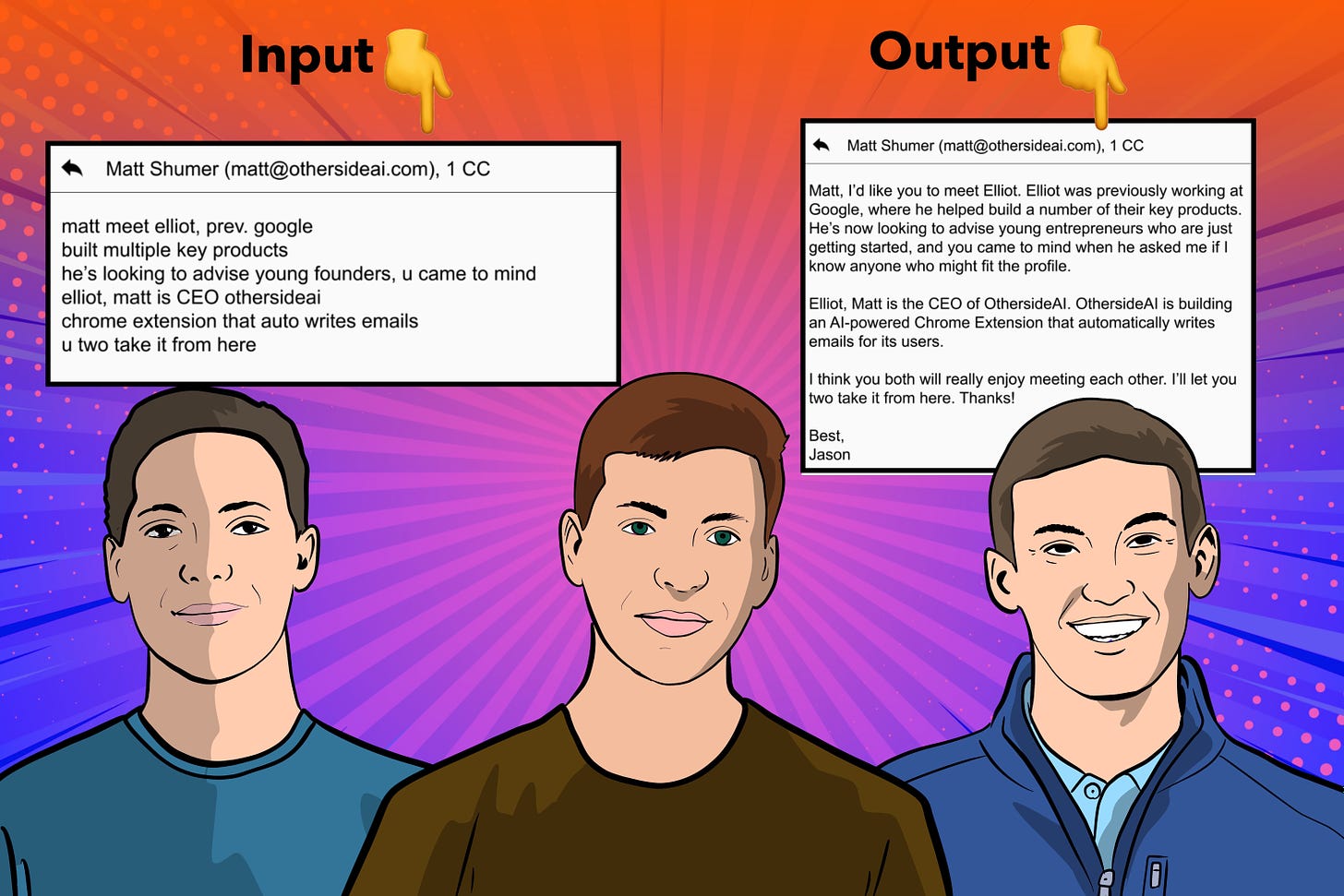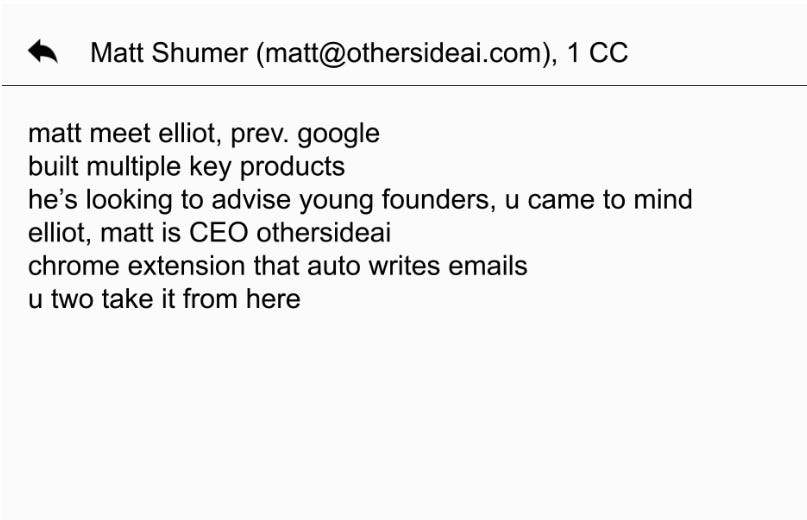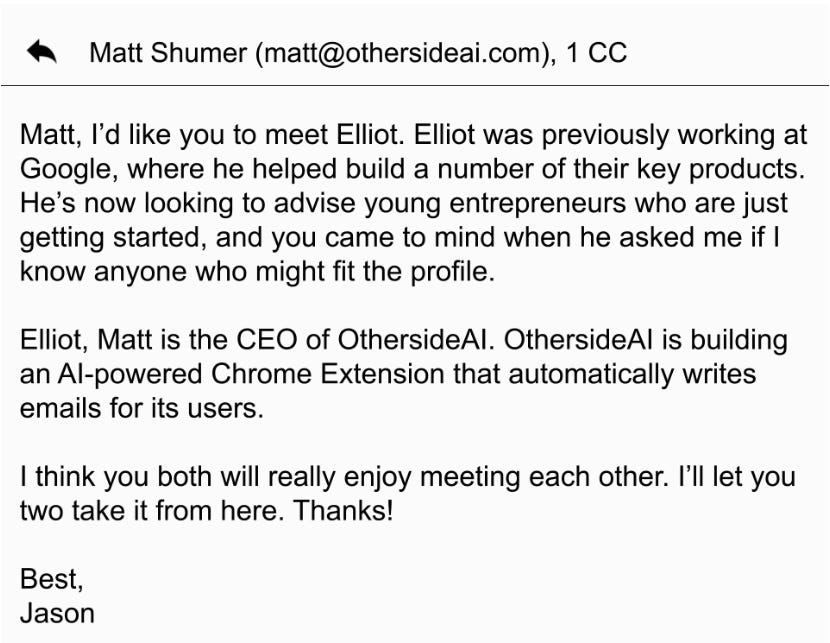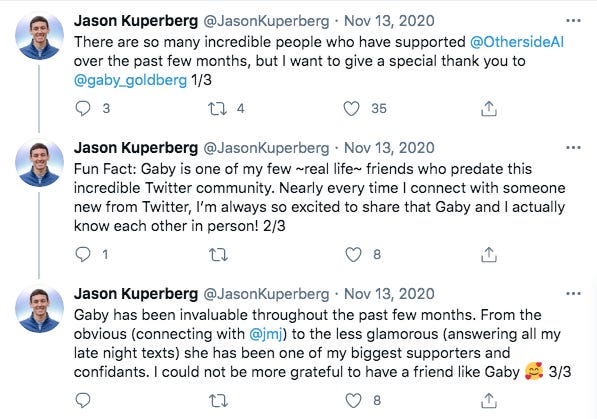How 3 College-Aged Founders Built a Demo in 2 Hours That Led to a 13k+ Waitlist and $2.6m
It was pretty much a text-book ideal startup 'launch'.
Hello 👋
Martin here. Welcome to another edition of Founders’ Hustle!
I produce content about the “hustle” of entrepreneurship and building startups.
Today I’m sharing how 3 college-aged founders built a demo in 2 hours, amassed a 13,000+ waiting list, and then raised $2.6m… all in a few months!
Social media was key, but they weren't influencers. 📈
A cold email accelerated their momentum. 📧
Leveraging powerful new technology made their demo hot. 🔥
OthersideAI was launched in the latter half of 2020 by three college-aged founders—Matt Shumer, Miles Feldstein, and Jason Kuperberg.
The company’s origin story is incredible.
It’s pretty much a text-book idealistic ‘launch’ framework for founders who want to build a venture-scale business.
Here’s a basic overview of key events. 👇
In July 2020 the team spent a few hours making a product demo and posted it to Twitter.
Without many followers, they didn’t expect much to come of it.
Instead, it went viral, receiving around 1,000,000 views and reactions from prominent figures in the venture capital and technology communities.
This triggered coverage in high-profile media outlets such as the New York Times and Fortune.
In the meantime, thousands of prospective customers put their names down for OthersideAI’s waitlist.
With this momentum they raised a $2.6m seed round from prestigious investors. 🔥
Now, they’re in a levelled-up position with a well-capitalised balance sheet, high public anticipation, and enthusiastic alpha testers.
But, like all things, highlights don’t reveal the whole story.
What were the underlying factors, steps, and frameworks that made this chain of events possible?
How can other founders replicate this process? Similarly, or even a diluted version.
I took a look. Here’s what I found out. 👀
So what exactly is OthersideAI? 🤔
How they put it:
Our AI writes your emails for you. Spend less time in your inbox, and more time on the things that matter.
To be clear—their software doesn’t make decisions or formulate opinions for you.
As the user, you input bullet points of the key information you want to convey and the AI transforms this into a fully-fleshed out email.
Input 👇
Output 👇
I know — wow! 😮
They’re building the product so the AI mimics the writer’s natural language style. This way everybody won’t sound like an automated robot. 🤖
The net result is a ‘10X’ faster emailing experience, which frees up a ton of time to do other things like hanging out with your dog—or quite likely—sending even more emails.
This was not one of those product demo scenarios where hype was artificially manufactured by domain-expertise influencers or marketing experts. The founders didn’t really have that kind of a platform.
Both the user experience and product proposition is intrinsically very cool and valuable. Make no mistake, this is a major contributing factor in their journey so far.
Their demo ‘sold itself’ and was fundamentally shareable, so it spread organically.
Why? It looked like you were viewing the future today. 🔮
If you’re already sold, you can put your name down on OthersideAI’s waitlist here.
But, what were the events that led to the demo?
And, what were the seeds that facilitated the demo to spread organically?
Let’s break that down. ⛏️
The three founders met at the Blackstone LaunchPad & Techstars at Syracuse University.
The idea for OthersideAI came from an experience CEO Matt Shumer had at his previous startup Visos.
Back then, without a network to tap into, Matt Shumer had to cold email practically anyone he wanted to connect with or pitch.
“I eventually came to the conclusion that I spend too much time writing emails and I tried to figure out a way to use [GPT-2] to cut that time down”—Matt Shumer
WTF is GPT-2? 🤔
Open-source artificial intelligence by OpenAI. Developers wield the AI to perform certain specific tasks. In this case, writing emails.
“So the idea originally was, can we do a better auto correct or something akin to Google’s Smart Compose, where it kind of suggests the next few words.”
We built that, and it actually worked out really, really well.”—Matt Shumer
But, it’s what came next that really ignited OthersideAI. 🔥
Around this time OpenAI announced and released GPT-3, the successor to GPT-2.
It was so more advanced than GPT-2 it may as well have been called GPT-10.
What you could do with it was mind-blowing and caused a social media frenzy in technology and venture capital communities.
An enthusiastic fanbase built and showed off GPT-3 demos, many of which became viral sensations for a few weeks in the summer of 2020. ☀️
But, not everyone could get their hands on GPT-3. OpenAI had an approval process and a long waiting list.
Not wanting to waste anytime, the OthersideAI team cold emailed the CTO of OpenAI, Greg Brockman, in an attempt to fast-track the process.
It worked! 💪
How? They told Greg Brockman what they wanted to do and it gave him the confidence to approve their access to GPT-3.
After that, no time was wasted.
“The day we got access [to GPT-3] we decided to see what we could do… and within about 2 hours we were able to whip up a demo that was just miles ahead of what we had. We really had something that can truly write emails for you.”—Matt Shumer
Two hours? Wow. 🤯
Matt Shumer said they were able to move that fast because of their prior experience experimenting with GPT-2. Fair enough. But still…
Next, they posted their demo on Twitter. Here’s the tweet:

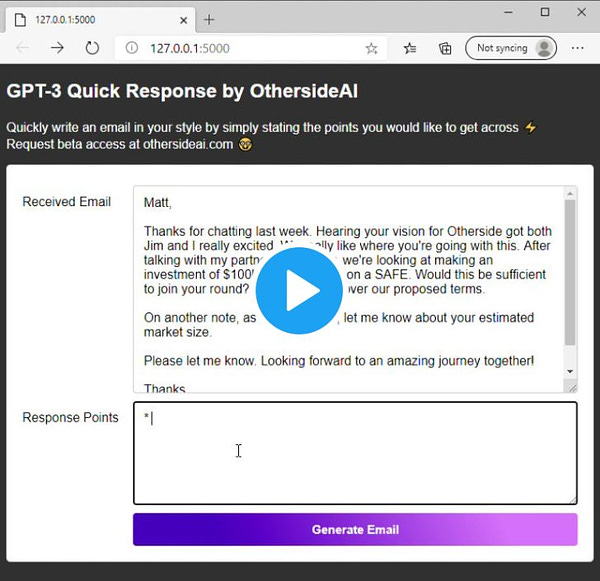
And, here’s another tweet from Matt Shumer a few days later that got even more likes:

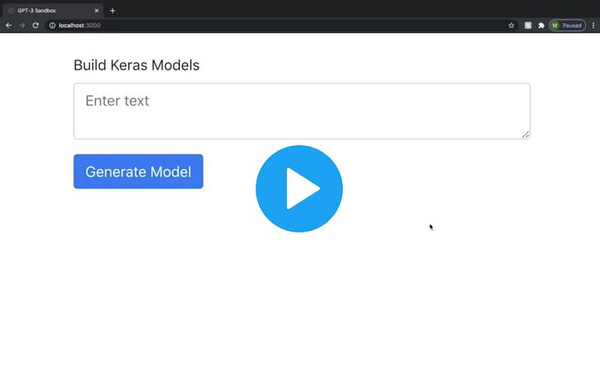
These tweets ‘went viral’ and generated hundreds of thousands of views. Eventually over 1 million.
They got the attention of people like former Shark Tank investor Chris Sacca, who retweeted and amplified the startup even more. 📈
This led to coverage in major publications like the New York Times. 👇
Sometimes journalists will just pick up on a story and write about it, other times you will have to reach out to them and bring it to their attention. I definitely prefer the latter approach since waiting around for something that may never happen is frustrating. ⌛
With hindsight it’s clear the huge buzz around GPT-3 increased the likelihood interest in this demo would ‘catch on’ and spread like wildfire.
Building a product with the latest sexy technology ‘everyone is talking about’ is a fantastic way to generate organic attention. When it’s combined with a truly valuable and futuristic proposition, the technology community can go wild.
But, how can a founder without much of a follower base catalyse a product demo tweet to go viral? 💥
From personal experience, you generally need an influencer account with a ton of followers to engage with your tweet. This initiates momentum that snowballs into ‘escape velocity’ virality.
But, unless you are already well-connected or an influencer it’s hard to get their attention by simply tweeting alone.
I put this question to CEO Matt Shumer:
“Retweets from Greg Brockman and Chris Sacca were what got the ball rolling.
I don't know how they found the tweet, but I'm glad they did :)”
—Matt Shumer
So, it seems like a mixture of an awesome demo and serendipity.
There are steps you can take to engineer a catalysing event for virality. I’ve done this personally, you can read up about it here.
But, you can’t make ‘anything’ go viral of course. The appeal of the content must be capable of ‘going viral’. This is the number one priority. ⚠️
Once you have this in place, you can directly engage accounts with a huge amount of followers and bring their attention to your content.
This can be through a mention, direct message, or even a well-written cold email.
Persistence is key. Keep at it.
Also, so is approaching relevant people.
For example, OpenAI CTO Greg Brockman was spot on for OthersideAI.
His followers are exactly the type of people that would take an interest in the OthersideAI demo.
A month later their waitlist hit 4,000 sign ups. 👇

As you can see, cofounder Miles Feldstein publicly confirmed they didn’t utilize prior connections or spend any money on advertising in order to build that incredible waitlist. 👊
But, that was months ago now.
Ever since they’ve continued to share their progress on Twitter, as well as taking interviews on podcasts and things.
At the time of writing their waitlist is around 13,000! 📈
So, how did all of this buzz translate into a $2.6m seed round?
Well, a mixture of momentum and connections.
Hustle Fund put the first check into OthersideAI—after an introduction from a mutual connection.
One of the founders, Jason Kuperberg, was fortuitously connected with investor Gaby Goldberg. 👇
Gaby made an intro to their second investor, Jeff Morris Jr., who later made introductions to other VCs and angels. 👇

And, Active Capital reached out to the OthersideAI team cold to invest. 👇

Although they had a valuable connection with Gaby Goldberg, I certainly do not get the impression this was crucial to closing a financing round in the absolute.
It was more of a case of optimizing the process of finding the most ideal investors the fastest way possible.
CEO Matt Shumer says the best way to secure investment is to tell a story.
At Matt’s previous startup he used to make pitch decks with 50+ slides and found that walking investors through it was boring. 😴
With OthersideAI the team opted for more of a conversational approach and instead made the dialogue fluid, two-sided, and engaging for investors.
What’s the end goal for the team?
“Free humanity from monotony—email is the first step.”—Matt Shumer
Actionable Summary
Here’s a quick recap on how to replicate OthersideAI’s framework:
🔥 Build with a hot new technology or trend.
😮 Make a demo that shocks or surprises a niche community.
☕ Post demo video where that community hangs out online.
🔗 Add link to a waiting list sign-up form.
🗣️ Draw attention to your demo from relevant influencers.
📰 Highlight demo traction and social proof with journalists.
🤝 Connect with investors and use momentum as leverage.
👉 You can join OthersideAI’s waitlist here. I did! 😄
Not subscribed to this newsletter? Let’s fix that right now 😉👇



